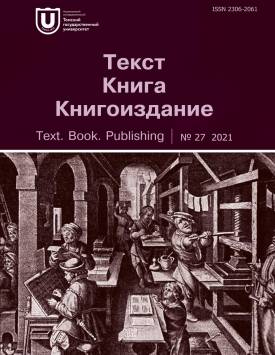Konstantin Vysotsky and the Media Revolution in a Siberian Regional Town of the Second Half of the 19th Century
The article describes the activities of Konstantin Vysotsky (1836-1886), who was first to open a photographic studio (1866), a lithographic studio (1867), a printing house (1869), and a newspaper (1879) in Tyumen. The first consideration of Vysotsky in the context of the history of the media and their transformations/revolutions contributes to the novelty of the research. It allows for a description of his experience of media transformations in a Siberian regional town of the second half of the 19th century in a systematic way, as opposed to the local and fragmentary descriptions which existed in science until now. The research methodology is integrative in nature: the study of book printing as a cultural practice in connection with economic, social and cultural transformations within the boundaries of cultural history (F. Barbier) is combined with contextual and intertextual approaches, bibliological and structural-typological analysis. The research material contains Vysotsky’s book, photographic, lithographic, and newspaper heritage stored in the Russian National Library, Tobolsk Historical and Architectural Museum-Reserve, I.Ya. Slovtsov Museum Complex (Tyumen), and the Digital Collection of the University of Tyumen entitled K.N. Vysotsky and the Media Culture of Tyumen. Vysotsky is presented both as an object and a subject of the economic, technological, social, and cultural transformations of the city. He was actively and creatively changing it. Based on the analysis of Vysotsky’s journalistic and publishing activities, his role in the history of the Tyumen shipping company and railway is revealed. The connection between Vysotsky and the landscape transformations of the city is shown. The idea that Vysotsky’s figure can be interpreted in the context of the phenomenon of new people in Russia in the 1860s-1870s is introduced. It is shown that the Tyumen generation of new people (N.M. Chukmaldin, K.N. Vysotsky, I. A. Kalganov, etc.) with their daily practices (reading, self-education, movement towards “light and will”, a new order in servant-master relations) was being formed largely under the influence of Nikolay Chernyshevsky’s novel What Is to Be Done? Tales of New People (1863), Nikolai Yadrintsev’s ideas of Siberian renovation, Ivan Turgenev’s interpretation of the image of Don Quixote (Hamlet and Don Quixote, 1860). Intertextual connections of the system of motifs revealing the image of new people in Nikolai Chukmaldin’s memoirs Notes on My Life (1902) and Chernyshevsky’s novel are presented. It is established that the first book published by Vysotsky, Charter of the Estate Manager Club in Tyumen, actually became a message about a new life of the city which Vysotsky and Chukmaldin addressed to the people of Tyumen. Another finding is the logic of Vysotsky’s professional development from photography to book printing. The author discusses the structure of the Vysotsky printing house repertoire dominated by documentary and non-fiction genres (road books, statutes, reports, calendars, catalogs, etc.). The complementarity of the book and visual (photographic and lithographic associated with the graphosphere) portraits of Tyumen created by Vysotsky contributed to a new hyper-reality which appeared in the city.
Keywords
book printing, lithography, photography, new people, media revolution, Tyumen, N.M. Chukmaldin, K.N. VysotskyAuthors
| Name | Organization | |
| Dvortsova Natalya P. | Tyumen State University | n.p.dvorcova@utmn.ru |
References

Konstantin Vysotsky and the Media Revolution in a Siberian Regional Town of the Second Half of the 19th Century | Tekst. Kniga. Knigoizdanie - Text. Book. Publishing. 2021. № 27. DOI: 10.17223/23062061/27/5
